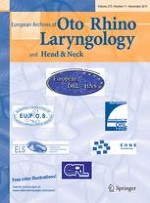Erschienen in:

01.11.2015 | Head and Neck
Assessment of caroverine as a potential chemotherapeutical agent in HNSCC cell lines
verfasst von:
Georg Haymerle, Dietmar Thurnher, Lorenz Kadletz, Isabella Stanisz, Markus Brunner, Ulana Kotowski, Elisabeth Enzenhofer, Gregor Heiduschka
Erschienen in:
European Archives of Oto-Rhino-Laryngology
|
Ausgabe 11/2015
Einloggen, um Zugang zu erhalten
Abstract
Since the prognosis of head and neck squamous cell carcinoma (HNSCC) still remains poor, identifying novel chemotherapeutic agents is of outmost importance. The anticancer potential of quinoxalines has been described in various tumor entities. Caroverine, also a quinoxaline derivative, has been shown to suppress tumor promotion factors. The aim of this study was to evaluate the effect of caroverine on HNSCC cell lines. The HNSCC cell lines SCC9, SCC25, CAL27, and FaDu were incubated with caroverine alone or in combination with cisplatin, 5-fluorouracil (5-FU) or cetuximab. Cell viability was measured using the CCK-8 assay. The murine 3T3 fibroblast cell line was used to address tissue specificity. Apoptosis was visualized by immunohistochemistry. Caroverine showed a dose-dependent growth inhibition in all cell lines, IC50 values ranged from 75.69 to 179.80 µM. This effect was increased when caroverine was combined with cetuximab or 5-FU. Immunohistochemistry displayed more apoptosis after caroverine treatment compared to controls. Furthermore, caroverine alone had no growth inhibitory effect on 3T3 cells. For the first time, this study provides evidence that caroverine may serve as a supportive drug in the treatment of HNSCC patients.